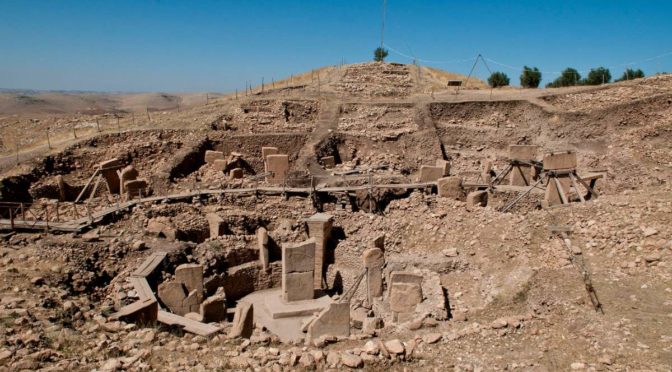Ancient symbols carved into stone at Göbekli Tepe (an archaeological site in Turkey) tell the story of a big comet impact more than 13,000 years ago, scientists think. The devastating impact triggered a mini ice age that drove many mammals weighing more than 40 kg to extinction.
According to an article published by New Scientist, carvings made on a pillar known as the “Vulture Stone” in Göbekli Tepe suggest that a swarm of comet fragments hit the Earth in around 11000 BC.

Göbekli Tepe was not only a religious site but also may have been an ancient observatory, scientists think. Animal carvings on pillar 43, also known as the Vulture Stone are interpreted as astronomical symbols. Using special software, scientists discovered a pattern between these carvings and the stars, and pinpointed the event to 10950 BC. This date also corresponds to other evidence for the impact from a Greenland ice core, which suggests roughly the same time frame.
One image of a headless man is thought to symbolize human disaster and extensive loss of life.

Göbekli Tepe
Göbekli Tepe (means “Potbelly Hill” in Turkish) is an archaeological site atop a mountain ridge in the Southeastern Anatolia Region of Turkey. It contains the world’s oldest known megaliths – erected circles of massive T-shaped stone pillars dated back to the 10th-8th millennium BCE.
While the Göbekli Tepe site formally belongs to the earliest Neolithic (PPNA), to date no traces of domesticated plants or animals have been found. The inhabitants are presumed to have been hunters and gatherers who nevertheless lived in villages for at least part of the year.

Göbekli Tepe is one of the most important archaeological sites in the world – if not the most important. First noted in a survey conducted by Istanbul University (Turkey) and the University of Chicago in 1963, it could “profoundly change the understanding of a crucial stage in the development of human society”. According to radiocarbon dating and comparative, stylistic analysis, it is the oldest religious site that has yet to be discovered.
Ian Hodder, the British archaeologist at Stanford University said, “Göbekli Tepe changes everything”. If, as some researchers believe, the site was built by hunter-gatherers, then it would mean that the ability to erect monumental complexes was within the capacities of these sorts of groups which would overturn previous assumptions.
Some researchers believe that the construction of Göbekli Tepe may have contributed to the later development of urban civilization: Klaus Schmidt, the German archaeologist, and pre-historian who led the excavations at Göbekli Tepe from 1996 to 2014, put it, “First came the temple, then the city.”
Today, less than 5% of the site has been excavated, and Schmidt planned to leave much of it untouched to be explored by future generations when archaeological techniques will presumably have improved.
Notes
- A pictogram, also called a pictogramme, pictograph, or simply picto, and in computer usage, an icon, is an ideogram that conveys its meaning through its pictorial resemblance to a physical object. Humans have been creating pictograms since the Stone Age. It is even possible that Neanderthal humans (H. neanderthalensis or H. sapiens neanderthalensis) were creating petroglyphs in the Lower Paleolithic, as far back as 700,000 BCE.
Sources
- Ancient carvings show comet hit Earth and triggered mini ice age on New Scientist
- Göbekli Tepe on Wikipedia
- “Pictographs of the Stone Age” on visual-arts-cork.com
- Moon Landings: All-Time List [1966-2025] - February 2, 2025
- What Is Max-Q and Why Is It Important During Rocket Launches? - January 16, 2025
- Top 10 Tallest Rockets Ever Launched [2025 Update] - January 16, 2025


